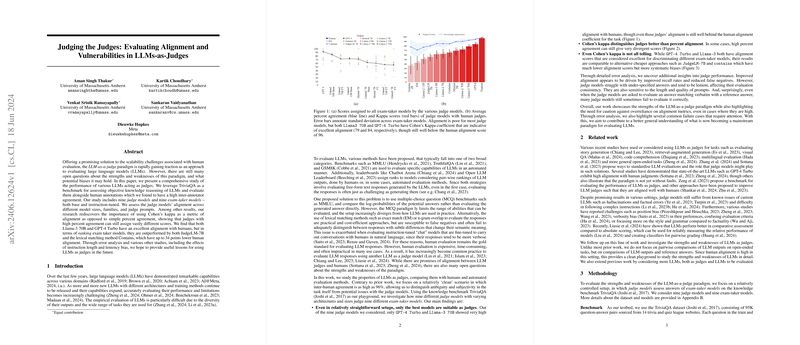Evaluating the Alignment and Vulnerabilities of LLMs as Judges
In the recent work titled Judging the Judges: Evaluating Alignment and Vulnerabilities in LLMs-as-Judges, researchers Aman Singh Thakur, Kartik Choudhary, Venkat Srinik Ramayapally, Sankaran Vaidyanathan, and Dieuwke Hupkes present a comprehensive evaluation of using LLMs as judges in assessing responses from other LLMs. As computational models become more capable, scaling up human evaluation poses challenges in domains that require nuanced judgment. The paper aims to determine how well different LLM judges align with human evaluators and uncover the strengths and vulnerabilities of the LLM-as-a-judge paradigm.
The authors examined thirteen judge models across varying sizes and families, evaluating nine diverse "exam-taker" models that include both base and instruction-tuned versions. Their findings reveal that only the largest models such as GPT-4 and Llama variants achieve reasonable alignment with human judgments, but still fall short of reaching inter-human agreement levels. Notably, score alignment differences of up to 5 points persist between human and LLM-assigned scores, suggesting intrinsic discrepancies in judgment across different models.
A key insight from this paper is the identification of inherent vulnerabilities within judge LLMs. Judges exhibited sensitivity to the complexity and length of prompts, along with a bias towards lenient evaluations. Moreover, alignment metrics like percent agreement, commonly used in evaluation, do not adequately reflect true alignment as they fail to distinguish variations among models effectively. Scott's Pi coefficient proved to be a more reliable metric, offering greater insight into the judges' performance against human standards.
The implications of this research extend both practically and theoretically. Practically, while LLM judges can serve as scalable, cost-effective evaluators, the caution against over-reliance on alignment metrics is warranted due to their observed divergence from human judgment in structured tasks. Theoretically, the findings indicate that despite advanced training, even state-of-the-art LLMs retain biases and limitations that necessitate closer examination and refinement.
The paper speculates on future developments wherein the refinement of alignment techniques and better understanding of LLM limitations could improve judge model effectiveness. Additionally, the differentiation between how models perform in terms of discrimination rather than absolute scoring may inform future enhancements and applications of LLM judges.
In conclusion, the comprehensive assessment conducted in this paper informs the broader scientific discourse on evaluating LLMs and emphasizes the utility and limitations of employing LLMs as evaluators in both academic and industry settings. Future work will likely further probe these aspects across more complex scenarios, aiming to enhance alignment and address intricacies in automated evaluation tasks.
